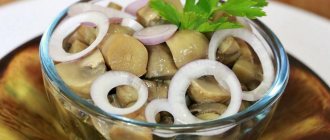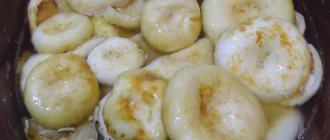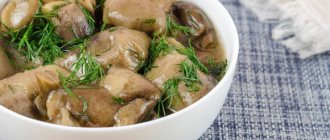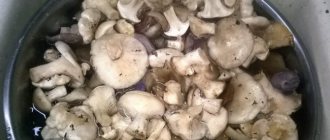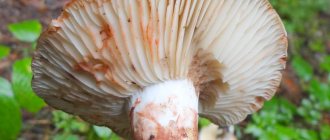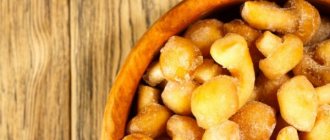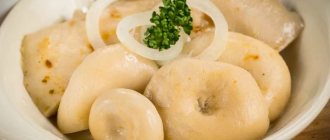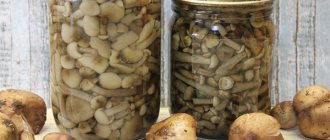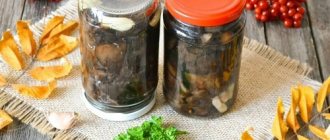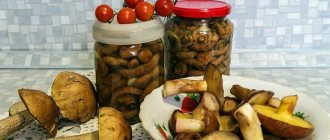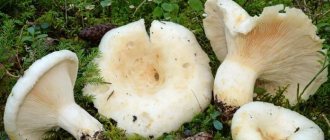In traditional Russian cuisine, mushrooms occupy a special place, since in terms of their nutritional value they can serve as a worthy alternative to meat, fish or seafood. Mushrooms have excellent taste and a unique aroma, and thanks to the high content of plant proteins, vitamins and microelements, they help make a regular, lenten or vegetarian menu more satisfying and varied. In order to have a supply on hand for the whole winter, during the harvesting period it is customary to salt, pickle, dry or freeze mushrooms.
Mushroom preparations are in constant demand and help diversify the winter menu
More than 200 species of edible mushrooms grow on the territory of Russia, of which only 57 are allowed for industrial harvesting and are included in the standards for mushroom products. The full list is given in the sanitary rules SP 2.3.4.009-93 (current edition of 1993), developed by specialists from the Institute of Nutrition of the Russian Academy of Medical Sciences, Moscow State University. M.V. Lomonosov and the State Committee for Sanitary and Epidemiological Surveillance of the Russian Federation. Based on nutritional value, mushrooms are divided into 4 categories:
- 1 - 2nd - edible. Regular cooking is enough for them;
- 3 - 4th - mostly conditionally edible. They require pre-soaking or boiling in several waters to eliminate caustic or bitter substances contained in their fruiting bodies.
The first category includes only 3 species: white mushroom (Boletus edulis), saffron milk cap (Lactarius deliciosus) and milk mushroom (Lactarius resimus).
Porcini mushrooms are distinguished by their dense pulp and delicious taste; they are used for all types of homemade preparations.
The second group consists mainly of tubular (or spongy) - boletus, boletus, boletus, and Polish. Of the lamellar mushrooms, this includes champignons (common, field, cultivated), milk mushrooms (yellow, aspen) and white milk mushrooms.
Numerous russulas, moths, rows, oyster mushrooms, chanterelles, honey mushrooms, pigweeds, moss mushrooms and other widespread species are included in categories 3 and 4 as conditionally edible.
With a huge variety of mushrooms, the situation is further complicated by the fact that the same species can have different names depending on where it grows. For example, valui (from the Russula family) in some regions is called goby, plakun, uryupka, and in others - svinur, cowshed, kubar, podtopolnik, etc.
If you are not well versed in mushrooms, do not take everything that comes to hand in the forest. Edible varieties are easily confused with inedible or poisonous ones, which can cause serious poisoning. It is dangerous to eat even edible mushrooms when they are overripe, spoiled or softened.
Experienced mushroom pickers usually take only 5-10 species that are well known to them for food and preparations, using each mushroom for a specific purpose.
What you need to know when going into the forest
To prevent a trip to the forest from being in vain, you need to know the simple rules for collecting mushrooms:
- Collect only known specimens.
- Place young and worm-free ones in the basket.
- In order for the mycelium to produce a new harvest, tubular mushrooms are twisted out, and lamellar mushrooms are cut off with a sharp knife.
- They do not grow in windbreaks or tall grass.
- Place only in baskets, as they quickly deteriorate in bags, plastic or metal buckets.
Every mushroom picker knows that mushrooms are collected from spring to autumn. But autumn ones are more popular, since they can be prepared for future use: pickled, dried and salted. Pickling is an ideal way to preserve forest fruits for a long time.
List of forest edible mushrooms with photos and tips for novice mushroom pickers
Mushrooms are considered edible; they can be used as food with absolutely no risk to life and health, since they have significant gastronomic value, are distinguished by a delicate and unique taste; dishes made from them do not become boring and are always in demand and popularity.
Good mushrooms are called lamellar, on the underside of the caps there are lamellar structures or spongy, since their caps on the underside resemble a sponge, inside of which there are spores.
When picking, experienced mushroom pickers always pay attention to special signs that a mushroom is edible:
frequency of the plates;- what color are the spores;
- how the plates are attached to the leg;
- change in color of the pulp when pressing on it.
Forest mushrooms grow from a mycelium that resembles a grayish light mold that appears on a rotting tree. Delicate fibers of the mycelium intertwine the roots of the tree, creating a mutually beneficial symbiosis: the mushrooms receive organic matter from the tree, and the tree receives mineral nutrients and moisture from the mycelium. Other types of mushrooms are tied to tree species, which later determined their names.
The list contains wild mushrooms with photos and their names:
- boletus;
- registry;
- boletus;
- subdukovik;
- pine mushroom;
- speckled oak or common oak, others.
In coniferous and mixed forests there are many other mushrooms that mushroom pickers are happy to find:
During harvesting, it is best to place mushrooms in special wicker baskets, where they can be ventilated; in such a container it is easier for them to retain their shape. You cannot collect mushrooms in bags, otherwise, after returning home, you may find a sticky, shapeless mass.
It is allowed to collect only those mushrooms that are definitely known to be edible and young; old and wormy ones should be thrown away. It is better not to touch suspicious mushrooms at all and avoid them.
The best time to collect is early in the morning, while the mushrooms are strong and fresh, they will last longer.
Pickling rules
All edible mushrooms are suitable for pickling, both tubular and lamellar. The main thing is that these are strong young specimens without signs of a wormhole. Before salting, they are washed, and those that contain bitterness are soaked (volnushki, milk mushrooms, bitter mushrooms and valui).
There are several methods of pickling at home:
- cold method with pre-soaking;
- cold method without soaking;
- hot method.
Cold method with soaking
The usual method, which is suitable for all mushrooms that contain bitterness. They are washed and cleaned of contamination. Then fill with salted water (add ½ teaspoon of salt per liter of water). To quickly get rid of bitterness, the water must be changed several times a day.
Soaking time:
- milk mushrooms – 5 days;
- valui – week;
- waves - 2 days.
After soaking, the fruits are cleaned again and placed caps down in a clean container. Each layer is salted. Horseradish leaves, bay leaves, dill, currant, cherry and oak leaves, as well as pepper and cloves to taste are placed on the bottom of the container and on top.
The prepared mushrooms are covered with clean gauze, a disk and a press is installed. After a short time, a brine appears in which the mushrooms will be salted.
You don’t have to add spices and herbs to the milk mushrooms.
Cold method without soaking
The mushrooms are cleaned of soil and dirt, washed thoroughly and placed with their caps down in layers. Each layer is salted. To add flavor, you can add horseradish leaf, dill, allspice and black pepper, oak and currant leaves.
Readiness dates for some mushrooms:
- saffron milk caps - a week;
- milk mushrooms - month;
- valui – 2 months;
- waves - 40 days.
The best container for pickling is an oak barrel. After complete filling, the mushrooms are covered with clean gauze, a wooden disk and a press are installed. If the brine has not formed, it is necessary to select a larger size bend.
Hot salting
Accelerated method. Most specimens can be tasted within a few weeks. Mushrooms with bitterness are pre-boiled in salted water for about half an hour. Milk mushrooms - for 5 minutes.
Russulas, champignons and mushrooms do not need cooking; they are doused with boiling water and kept in it for about half an hour. After the preparatory stage, the mushrooms are pickled, as with the cold method.
The hot method is very popular because it does not require much time and effort.
Preparatory stage of salting
Before you start pickling, you need to prepare everything. At the first stage, mushrooms are sorted by size and type, cleaned of dirt, cut and soaked.
Sorting
Sort your crops by type. Housewives claim that the most delicious mushrooms are obtained when several types are mixed. This may be true, but each individual sample requires different heat treatment times.
Cleaning
Clean the raw materials from dirt. If there are damaged areas, cut them off. The easiest way to remove dirt under the cap of lamellar representatives is with a soft toothbrush.
Slicing
If the caps are large, it is better to cut them in half. To save time, you can simply do this while cleaning.
Soaking
Next comes soaking. The procedure is carried out only for those representatives that contain dangerous milky juice. It is important to adhere to the time, which differs for different varieties.
Storing salted mushrooms
You can store workpieces only in a cool, ventilated room. The ideal temperature for storage is 6 degrees. It should not fall below the 0 mark, since at sub-zero temperatures the mushrooms crumble and lose their taste. If it is high, they sour and become unsuitable for food.
When salting, you need to monitor the brine. If it has evaporated, add boiled salted water.
If mold appears, the circle and gauze are washed and scalded with boiling water.
Cold way
If we salt mushrooms in a cold way, the container in which they will be placed must be boiled with boiling water, or better yet, with a decoction, for the preparation of which it is recommended to use juniper branches. Your favorite spices are poured into the bottom of the container, most often blackcurrant and cherry leaves, dill, garlic, horseradish, bay leaf, cloves, pepper and others. Then a layer of mushrooms is laid out on the spices, but always with the caps down, but it should not exceed 5–8 cm; each of the balls is topped with salt in the proportion of 40–50 grams per 1 kg of fruit.
Next, the product is covered with gauze, and a wooden circle is placed on top, and pressure is placed on it. The mushrooms will gradually shrink, and therefore you can add new layers to them until the bowl is completely filled. The prepared dishes are left at medium temperature.
During the salting process, it is periodically necessary to change the material to clean material, as well as rinse the oppression and carefully monitor so that mold does not form. If this does happen, then you need to change the gauze and wipe the walls with a wet rag. After 6 days, the mushrooms will thicken well, and brine and a strong aroma will begin to appear in the dishes. After this point, the container is sent to the cold.
The finished product can be tried after a few months.
Salted mushrooms - proven recipes
How to pickle mushrooms depends on the variety, since each has its own characteristics and taste. To get a tasty preparation, you need to learn how to salt them correctly. For any recipe there are general recommendations:
- It is advisable to salt only the caps.
- It is better to salt pork, honey mushrooms and morels using the hot method.
- To remove severe contamination, mushrooms are soaked in saline solution.
- To lighten fruits during hot pickling, add 1 tsp. lemon juice.
- Oak barrels are the best container for pickling; aluminum buckets are not suitable.
- In order not to interrupt the taste of milk mushrooms, spices and herbs are not added.
- Before closing, jars must be clean, or preferably sterilized.
To ensure that the mushrooms retain their forest aroma, you can put heather or spruce branches between the layers.
How to collect?
Every experienced mushroom picker will confirm that harvesting for future use begins in the forest, at that very moment when you bend down, noticing a cap among the leaves and grass, to get a forest trophy, cutting it off at the root. The finished product will only be tasty if the harvest is harvested correctly.
The selection of raw materials must be done away from the highways, since these plants strongly absorb toxic emissions, and after eating such a treat, you can experience very serious health problems. You need to go into the forest at least a kilometer from the highway, this is where those specimens grow that are suitable for pickling for the winter. It is better to pick mushrooms in the morning, it is at this time that they contain the greatest amount of useful substances, and the caps are more elastic. It is recommended to leave overgrown plants as food for local inhabitants, because, as a rule, such mushrooms are tasteless and wormy. The most ideal are considered to be medium-sized specimens with fixed and even caps.
Honey mushrooms
Honey mushrooms are agaric mushrooms that grow in large, close families on stumps and trees.
Many mushroom pickers confuse edible and false honey mushrooms. How to distinguish them?
| Appears in August and grows until the first frost. The mushroom cap is round, copper-colored with small scales. Young specimens have a thin film under the cap. The plates are light, the stem is thin and elongated, the pulp is coffee-colored |
| Grows in families on birch stumps. False honey fungus is similar to an edible mushroom, but has a rounded flat cap of a dirty lemon color. The plates are greenish-dirty in color. When a leg is broken, colored milky juice is released. |
Hot salting method
Ingredients:
- honey mushrooms – 3 kilograms;
- salt – 9 tbsp. l. ;
- bay leaf – 7 pieces;
- pepper, bay leaf, horseradish, currant, cherry and oak leaves - to taste;
- onion, dill - 60 grams each.
Preparation:
Wash the mushrooms, separate the stems from the caps and boil for half an hour in salted water. When cooked, they begin to darken and to return the original color, you can add lemon juice to the water.
Place the mushrooms in a colander to remove the liquid. After cooling, we proceed to salting.
Place the spices in the prepared container, and then the legs and caps.
We salt each layer, cover the top one with horseradish leaves and clean gauze. We install the wooden disk and the bend.
Leave to pickle for 2-3 weeks.
Salted mushrooms in cucumber brine
Honey mushrooms cooked in brine are very aromatic and crispy.
Products for 1 kg of mushrooms:
- cucumber pickle - half a liter;
- salt – 1 tbsp. l. with a slide;
- bay leaf and dill - 1 piece each;
- pepper, cloves - to taste.
Preparation:
Wash the mushrooms and place them in a saucepan. Fill with salted water (use 10 grams of salt per 1 liter). Bring to a boil, drain all the liquid and wash the mushrooms.
Place them in cold water and cook for about half an hour. Next, put it in a colander to get rid of the water.
Place spices and cooled mushrooms on the bottom of the pickling container. Sprinkle each layer with salt and fill with cucumber pickle. We put pressure on it and put it away for a week in a cool place.
After 40 days you can make the first test.
A quick way to pickle honey mushrooms
This method is simple and easy to perform.
Ingredients for 1 kg of honey mushrooms:
- white salad onion – 1 head;
- cumin – 1 tbsp. l. ;
- bay leaf, dill, pepper - to taste;
- cloves - 2 pieces;
- salt – 2 tbsp. l. without slide;
- garlic – 4 cloves.
Cooking method:
We fill the washed honey mushrooms with water, to which cumin, bay leaves, salt and an onion wrapped in gauze have been added.
After the water boils, reduce the heat and leave to simmer for about half an hour, remembering to skim off the foam.
Place the boiled mushrooms in a colander to remove the liquid.
Place garlic, dill, pepper, cloves and bay leaf into the prepared jar. You can also add cherry and currant.
We put the honey mushrooms into jars and fill them with boiling brine up to the shoulders. Roll up the lids and leave for a week to salt.
Selection and preparation of ingredients
Home-made pickling of mushrooms may differ in the methods of their preparation, but there are general principles that should not be neglected - preliminary heat treatment of the mushrooms, the ability to combine all the mushrooms intended for pickling in one container, the mandatory use of sterile wooden, glass, porcelain or enamel dishes with a wide throat for oppression and air access , exceptional freshness and preliminary cleaning of mushroom raw materials.
Whether you use spices or not is up to you. Experienced mushroom pickers do not add spices at all , but in traditional recipes you can often find small quantities of black currant leaves, laurel and horseradish leaves, garlic, dill, allspice, cumin or cloves, in non-traditional recipes even cinnamon and barberry.
Did you know? Serushki, unlike other milkweeds, do not release bitter juice, therefore, of the lamellar species, only they and chanterelles are suitable for dry salting.
Milk mushrooms
Milk mushroom is a favorite of many mushroom pickers. There are a considerable number of species in nature, but mushroom pickers prefer white and black ones.
White milk mushrooms belong to the first category, have a hollow stem and a funnel-shaped cap of milky white color. After salting, they are very tasty and aromatic, acquiring a bluish tint.
Black ones grow until frost. The hat is painted black and green, so in common people they are called gypsies or nigellas.
Salted black milk mushrooms
Ingredients for 1 kg of milk mushrooms:
- refined oil;
- water;
- dill;
- garlic – 5 cloves;
- salt – 2.5 tbsp. l.
Cooking method:
Add oil to the water and add the washed mushrooms. Boil for 7 minutes, place in a colander to remove liquid.
Transfer the mushrooms to a wide container, add dill, chopped garlic, and salt. Mix everything, cover with a towel and set up a press to obtain brine.
After 12 hours, mix again and leave under pressure for 12 hours.
Place the mushrooms in a jar, compact them, add dill and fill with brine so that they are completely covered.
Seal the jar with a lid and put it in the refrigerator for salting. After 30 days you can make the first test.
Cold salted milk mushrooms
We take milk mushrooms into a bucket:
- salt – 2 cups;
- pepper and bay leaf - per package;
- blackcurrant leaves, horseradish and dill umbrellas - to taste;
- garlic - 1 head.
Cooking method:
The washed milk mushrooms are placed with the plates up on dill, currant and horseradish leaves. Large specimens are divided into several parts.
Each layer is salted and bay leaf, dill, chopped garlic and pepper are added. The topmost layer is covered with horseradish leaves and dill. Cover with gauze, install a disk and press to obtain brine.
After the juice appears, the mushrooms are removed for a week in a cool room. After a week, they are placed in jars, adding brine and sealing. Store in the refrigerator.
Hot salted milk mushrooms
For 1 kg of milk mushrooms you will need:
- laurel;
- garlic – 3-5 cloves;
- dill and currant leaves;
- horseradish root;
- salt.
Cooking method:
Remove the stems from washed mushrooms.
Prepare brine at the rate of 2-3 tbsp. l. salt per liter of water. Dip the milk mushrooms into it and boil for half an hour, constantly removing the foam. After 30 minutes, drain the mushrooms into a colander and rinse under the tap.
Place spices and mushroom caps on the bottom of the prepared container. We salt each layer.
Cover the top layer with a towel and install the press. After 2 days, after the brine has formed, remove the container to a cool room. After a month you can do the first test.
Chanterelle
Preparation time: 1 hour (+1 month).
Number of servings: 10-15.
Calorie content of the dish: 20 kcal/100 g.
Purpose: snack.
Cuisine: Russian.
Difficulty of preparation: easy.
Pickling chanterelle mushrooms can be done in any way, but this recipe refers to the cold method. As a rule, they take a little more of this variety, because the specimens are not large. Salting chanterelles is done quickly, but they must then stand under pressure for at least a month to reach the state of readiness. Below is a recipe on how to properly salt this type of mushroom.
Ingredients:
- dill – 1 bunch;
- chanterelles – 2 kg;
- salt – 500 g;
- garlic – 6 cloves.
Cooking method:
- To pickle, you must first boil the mushrooms. To do this, put the pan on the fire in advance.
- At this time, prepare the components, remove dirt, twigs and leaves, and change the water several times. This will help separate everything unnecessary from the total mass.
- Place the prepared mushrooms into boiling water. They should cook for about 25 minutes.
- Rinse the chanterelles again, change the water several times, and place them in a colander to drain.
- Peel the garlic, cut into thin slices, wash the dill, remove the yellow branches.
- Wash and dry the pickling container, add salt to the bottom, then half the garlic and dill.
- Place the mushrooms caps down, sprinkle each layer with salt. Post until all the chanterelles are gone. Pour the remaining garlic, dill and salt onto the very top.
- Cover the container with a clean, dry cloth, then a flat, large dish and place pressure. It should be kept for 1 month, and the workpiece should be stored in a dark, dry place.
- After 30 days, transfer the mushrooms into sterile jars and roll up the lids.
Volnushki
Volnushka belongs to the Syroezhkov family. In young specimens the cap is convex, but with age it becomes flat with a deep depression in the center. The leg is strong and hard, pale pink in color.
When the plate is broken, abundant snow-white milky juice is released. The flesh of the mushroom is light, the taste is sharp and bitter.
Cold salting of volushki
For salting you will need:
- wavelets - 7 kilograms;
- salt – 200 grams;
- lemon juice – 1 tsp. ;
- dill and caraway seeds;
- cabbage leaf – 1-3 (across the width of the barrel).
Cooking method:
Soak clean mushrooms in salted, acidified water for 3 days, refreshing it periodically.
We lay the waves in layers with the plates facing up. Mix salt with cumin and dill. Salt each layer with this mixture. We cover the top one with cabbage leaves, install a wooden disk and place a weight.
We put the container in a cool room for several months. Before serving, the volushki must be soaked.
The same method can be used to pickle russula and champignons.
Video
We offer you several more recipes for pickling certain types of mushrooms: black milk mushrooms, valuev and russula
Marinating and salting are different processes. Read about the principles of pickling mushrooms in this article.
For several years she worked as a television program editor with leading producers of ornamental plants in Ukraine. At the dacha, of all types of agricultural work, she prefers harvesting, but for this she is ready to regularly weed, pull, shed, water, tie, thin out, etc. I am convinced that the most delicious vegetables and fruits are those grown with your own hands!
Found a mistake? Select the text with the mouse and click:
Natural toxins are found in many plants; Those grown in gardens and vegetable gardens are no exception. Thus, the seeds of apples, apricots, and peaches contain hydrocyanic acid, and the tops and peels of unripe nightshades (potatoes, eggplants, tomatoes) contain solanine. But do not be afraid: their number is too small.
“Frost-resistant” varieties of garden strawberries (more often simply “strawberries”) need shelter just as much as ordinary varieties (especially in those regions where there are snowless winters or frosts alternating with thaws). All strawberries have superficial roots. This means that without shelter they freeze to death. Sellers’ assurances that strawberries are “frost-resistant,” “winter-hardy,” “tolerates frosts down to −35 ℃,” etc. are deception. Gardeners must remember that no one has yet managed to change the root system of strawberries.
You need to collect medicinal flowers and inflorescences at the very beginning of the flowering period, when the content of nutrients in them is highest. Flowers are supposed to be picked by hand, tearing off the rough stalks. Dry the collected flowers and herbs, scattered in a thin layer, in a cool room at natural temperature without access to direct sunlight.
One of the most convenient methods for preparing a harvest of vegetables, fruits and berries is freezing. Some believe that freezing causes the nutritional and health benefits of plant foods to be lost. As a result of the research, scientists have found that there is practically no decrease in nutritional value when frozen.
Oyster mushrooms
Oyster mushrooms are lamellar mushrooms from the Oyster family. The cap is shiny, sometimes with a coating of mycelium. The color can be either gray or ash-violet. The leg is dense and short.
Mushrooms have an unusual taste and a faint aroma.
Salted oyster mushrooms hot and cold
Ingredients:
- oyster mushrooms – half a kilo;
- water – 2 liters;
- salt – 3 tbsp. l.;
- pepper and bay leaf - to taste;
- garlic – 3 cloves;
- granulated sugar – 1 tbsp. l.
Cooking method:
Hot method. We separate the hats from the legs. We divide large ones into parts and wash them.
Boil water, add all the ingredients, add the mushrooms and boil for 10 minutes, remembering to remove the foam.
Transfer the cooled fruits into the prepared jars, add the garlic and close the lids tightly. A day later we make the first test. Store the finished product in the refrigerator.
Cold way. For 2 kg of mushrooms we take 200 grams of salt.
Place spices, salt and mushrooms in layers at the bottom of the container. We salt each layer. Cover the top one with a clean towel and apply pressure. You can taste the dish in a week.
The simplest salad
What salad can be prepared with salted mushrooms without wasting a lot of time? Exactly this one! To prepare it you need to take:
- one hundred grams of salted mushrooms, any;
- three pickled cucumbers;
- half a teaspoon of wine vinegar;
- a tablespoon of unrefined oil;
- a couple of green onions;
- a pinch of ground black pepper.
This salad is very easy to prepare! The onions are washed, mushrooms and cucumbers are also washed to remove excess salt. Mushrooms and cucumbers are cut into strips, onions are cut diagonally, coarsely. All ingredients are combined, seasoned with oil and vinegar, and pepper. Let it stand for ten minutes. This salad can also be used as an appetizer with simple side dishes.
Saffron milk caps
Ryzhiki are considered noble royal mushrooms. They grow in pine forests on sandy soil.
The mushroom cap is funnel-shaped and orange or brick-colored. The pulp is fleshy, when broken, it acquires a red and then green tint, and releases abundant bright orange milky juice.
Cold pickling of saffron milk caps
A common method of pickling, as it is easy to perform, and the preparations can be stored all winter.
For 2 kg of saffron milk caps you will need:
- salt – 3 tbsp. l. ;
- garlic – ½ head;
- currant leaves, allspice - to taste;
- bay leaf - 1 package.
Cooking method:
We clean the saffron milk caps, wash them and dry them.
Place spices and a little salt into the prepared container. We stack the mushrooms with their caps up, salting each layer, cover them with gauze and install the press.
After 6 hours they will settle and it is recommended to add a new batch for compaction.
Ryzhiki are salted at a temperature of 20 degrees. Every third day we wash the gauze and scald it with boiling water. It is also necessary to ensure that the mushrooms are constantly in the brine.
After 2 weeks, put the mushrooms in jars, add brine and put them in the refrigerator. Cooked saffron milk caps in this way can be stored for 2 years or more.
Wet
The moths are one of the first to grow in the fall. They may appear earlier, but it is in September that their growth peaks. To collect, you will need an individual basket or you will have to separate part of the general basket with it, otherwise they will stain all the other mushrooms. It is interesting that mokrukhas grow in almost the same places as porcini mushrooms, but later by half a month or a month.
Spruce weed (Gomphidius glutinosus)
Season: June-October.
Spruce weed (Gomphidius glutinosus)
Habitat: on the soil and forest floor in coniferous (especially spruce) forests, growing in groups or singly.
